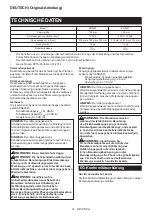
6 ENGLISH
SANDER SAFETY WARNINGS
1.
Always use safety glasses or goggles.
Ordinary eye or sun glasses are NOT safety
glasses.
2.
Hold the tool firmly.
3.
Do not leave the tool running. Operate the tool
only when hand-held.
4.
This tool has not been waterproofed, so do not
use water on the workpiece surface.
5.
Ventilate your work area adequately when you
perform sanding operations.
6.
Some material contains chemicals which may
be toxic. Take caution to prevent dust inhala
-
tion and skin contact. Follow material supplier
safety data.
7.
Use of this tool to sand some products, paints
and wood could expose user to dust contain
-
ing hazardous substances. Use appropriate
respiratory protection.
8.
Be sure that there are no cracks or breakage
on the pad before use. Cracks or breakage
may cause a personal injury.
SAVE THESE INSTRUCTIONS.
WARNING:
DO NOT let comfort or famil
-
iarity with product (gained from repeated
use) replace strict adherence to safety
rules for the subject product. MISUSE or
failure to follow the safety rules stated in
this instruction manual may cause serious
personal injury.
FUNCTIONAL
DESCRIPTION
CAUTION:
•
Always be sure that the tool is switched off and
unplugged before adjusting or checking function
on the tool.
Switch action
►
Fig.1:
1.
Lock button
2.
Switch trigger
CAUTION:
•
Before plugging in the tool, always check to see
that the switch trigger actuates properly and
returns to the "OFF" position when released.
•
Switch can be locked in "ON" position for ease
of operator comfort during extended use. Apply
caution when locking tool in "ON" position and
maintain firm grasp on tool.
To start the tool, simply pull the switch trigger. Release
the switch trigger to stop.
For continuous operation, pull the switch trigger and
push in the lock button and then release the switch
trigger.
To stop the tool from the locked position, pull the switch
trigger fully, then release it.
Speed adjusting dial
For Model BO5041
►
Fig.2:
1.
Speed adjusting dial
The tool speed can be infinitely adjusted between 4,000
and 12,000 orbit per minute by turning the adjusting
dial. Higher speed is obtained when the dial is turned in
the direction of number 5; lower speed is obtained when
it is turned in the direction of number 1.
Refer to the figure for the relationship between the num
-
ber settings on the adjusting dial and the kind of work.
A range: For polishing
B range: For finish sanding
C range: For regular sanding
1
2
3
Dial setting
Orbits per minut
e
4,000
12,000
4
5
A
B
C
NOTE:
•
The figure shows standard applications. They
may differ under certain conditions.
Summary of Contents for 0088381607308
Page 2: ...1 2 1 1 2 1 2 1 Fig 1 Fig 2 Fig 3 Fig 4 Fig 5 Fig 6 Fig 7 Fig 8 2 ...
Page 3: ...1 1 1 2 3 1 2 1 2 1 1 2 Fig 9 Fig 10 Fig 11 Fig 12 Fig 13 Fig 14 Fig 15 Fig 16 3 ...
Page 4: ...1 2 1 1 1 Fig 17 Fig 18 Fig 19 Fig 20 Fig 21 Fig 22 4 ...
Page 37: ...37 ...
Page 38: ...38 ...
Page 39: ...39 ...







































